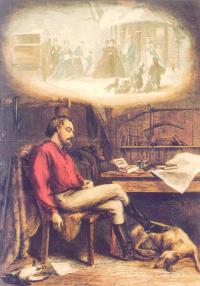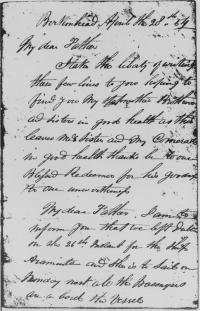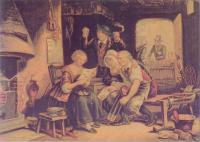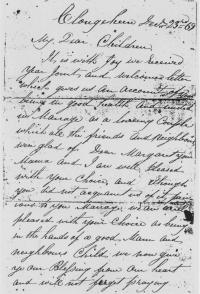Emigrant Letters I take up my pen to write these few lines by David Fitzpatrick
Published in
18th-19th Century Social Perspectives,
18th–19th - Century History,
Features,
Issue 3 (Autumn 1994),
Volume 2

The Bushman’s Dream 1869 by Thomas Selby Cousins. (COURTESY OF NATIONAL LIBRARY OF AUSTRALIA)
The uses of literacy, the ability to read and write, are central to the construction of popular culture. Cultural historians have long been engrossed with the reading habits of ordinary people, hoping to find clues to their knowledge, beliefs, expectations and fantasies. Yet the forms and functions of popular writing have been largely ignored. This neglect is perhaps attributable to problems of evidence. A single chapbook may illuminate the mentality of a thousand readers, whereas a thousand letters may fail to reveal the intentions of a single writer. Even so, the personal letter offers a powerful challenge to historians concerned with the uses of the written word for those with rudimentary education. Until recently, the scarcity of accessible plebeian letters provided a plausible excuse for inactivity. This excuse has been undermined by the growing interest of descendants in the private writings of their ancestors. The value of old letters, once appreciated only by stamp-collectors, has attracted particular attention from the armies of ‘roots-hunters’ from America and Australasia, who swarm every summer over the libraries of Europe and Ireland. Their efforts have uncovered tens of thousands of private letters, sent or received by the emigrants of the last century or so. Some of these documents have been deposited in archives, though many remain in private possession. A couple of thousand letters survive to represent the Irish in Australia, providing the basis for what follows.
Historians and letters
Historians of emigration were, understandably, among the first to edit or extract plebeian letters. In addition to generating many compilations by family historians, emigrant letters have been exploited by a distinguished line of scholars, stretching from Thomas and Znaniecki to Kerby Miller and Patrick O’Farrell. With few exceptions, these studies have used letters purely as a source of ‘factual’ illustration, the often quaint phraseology providing an additional gloss of authenticity by comparison with the newspaper report or emigrant manual. The letters have been allowed to ‘speak for themselves’, offering seemingly direct access to personal experi-ence as described for an intimate circle. Even Miller and O’Farrell, two of the finest historians of Irish emigration, have scarcely concerned themselves with the details of personal or local background. Still less interest has been expressed in the functions of letter-writing or the genres of ‘epistolary discourse’, though Stephen Fender has belatedly alerted literary critics to the distinctive idiom and rhetoric of emigrant letters.
The bare facts
Should letters be left to ‘speak for themselves ‘? Consider this message from Isabella Wyly in Adelaide to the widow of her brother Thomas in Newry, sent in about December 1857: I think I told you before that I had become quite a Wesleyan I hope not in Name only but in heart. I have been one now for 4 years and I hope I shall Dye one, and I trust a Good one. But it does not mater what you ar by Name as long as you belong to that one church that is the church of God, and I hope we are all united to that one. The only ‘fact’ conveyed by this passage is an emigrant’s conversion from an unrevealed denomination. That bare fact takes on richer meaning when we investigate Isabella’s background. Her parents were lapsed Quakers who had been converted to the Church of Ireland. A sister had caused a sensation in 1841 by eloping to the Presentation convent at George’s Hill, Dublin, only to be abducted by brother Thomas in company with the firebrand preacher, T. D. (Trash’) Gregg. Conversions were clearly a delicate matter in the Wyly family. Isabella’s change of affiliation should also be set in the unique context of South Australia, that ‘paradise of dissent’, where Wesleyanism was the dominant faith among the oligarchy. Furthermore, the passage may have fulfilled a hidden function by preparing the Irish Wylys for Isabella’s future marriage, to her Wesleyan employer. Finally, the form of the letter invites analysis, in its use of conventional phrases naively strung together and imperfectly spelt. Indeed, the ‘bare facts’ are perhaps the least interesting element of emigrant letters.
Oceans of Consolation
Making sense of emigrant correspondence is a daunting undertaking. The construction of my book, Oceans of Consolation, indicates one strategy for teasing out personal meanings without abandoning the quest for a general analysis of the migratory experience. The book includes the full and undoctored text of fourteen sequences, covering the period 1843- 1906 and containing over a hundred letters, out of the thousands that survive and the millions that must have been written. Many of these letters were located through public appeals in both Ireland and Australia. Clearly, no such selection should be presented as a ‘sample’, either of letterwriters or of the whole body of IrishAustralian emigrants. Instead, I have sought out the atypical minority of letters by the unlettered. My selection is dominated by Catholics, the rural poor and the ill-educated, matching their predominance among Irish emigrants. Letters from home are given no less prominence than those sent by emigrants, since these accounts of changing conditions in Ireland offer fascinating insight into Irish mentality. Despite the shortage of surviving letters by women, these account for one selection in three. Although these individual voices cannot speak for the silent thousands, they address problems of separation and adjustment that must have confronted innumerable families splintered by migration.
Commentaries
Each sequence is accompanied by a commentary, reconstructing the family and local contexts in both Ireland and Australia. Using the finding aids and techniques developed by family historians, I have been able to follow the paths of migration in some detail. It is heartening to discover that almost every emigrant correspondent, however obscure, left some traces in the records of both countries. My intention is to allow the reader to eavesdrop on these semiprivate conversations, filling in some of the silences and decoding inexplicit messages. We also learn something about those receiving the letters, making up for the predictable loss of one side of almost every correspondence. On occasion, the background research provided a ‘key’ to otherwise perplexing passages (convict origins, or a mixed marriage). By relating the letters to the lives of their writers, I have tried to illustrate the ulterior uses of ‘factual’ statements. Seemingly objective accounts of economic conditions in Australia, or the prospects of particular classes, may often be interpreted as tactical statements, intended to encourage or discourage further migration by particular relations or neighbours. Semi-privacy The interpretation of letters demands close attention to their intended functions. French historians have rightly emphasised the need to define the ‘space’ within which correspondence is conducted. Though personal and sometimes intimate in tone, it is evident that these letters were collaborative rather than strictly private. Messages were sent to a vast range of relations and neighbours, and writers were conscious that their words would be quite widely broadcast. This is confirmed by references to other people’s letters, which were often cited in order to goad a correspondent to write more often, send more money, or check some dubious report. The act of writing, too, was often collaborative. Some letters have several signatories, and others were inscribed by an amanuensis-often the sender’s better-educated son or daughter. The possibility of dictation enabled many of the sub-literate to overcome the most obvious impediment to letter-writing. Thus IrishAustralian letters typically had the somewhat guarded character of semiprivate rather than private communications. Even when the soul was bared, it was done self-consciously before a mixed audience.
Functions
A central function of emigrant correspondence was to assert the writer’s continuing stake in the everdispersing networks stretching out from ‘home’. The emigrant used words to maintain emotional, social and economic ties, in defiance of physical separation. The untutored eloquence and rhetorical prowess of many Irish writers enabled them both to offer and solicit consolation, and to reinforce affection, love and sympathy. Letters were used to influence home decisions, to tease out news of family enterprises, and above all to regulate future emigration. Parents in Ireland, sometimes no less isolated than their emigrant children, likewise interfered with decisions in Australia. The traffic in money, as well as moral suasion, occurred in both directions. The best-documented practical consequence of correspondence was the organisation of further movement, and letters provide unrivalled insight into the construction of ‘chain’ migration. The Australian nomination system, whereby free passages were provided on payment of a non-refundable deposit by a colonial resident, gave emigrants particular power over the selection of successors. We are able to follow the often elaborate process of negotiation, chart the arrival and settlement of nominated emigrants, and trace their own subsequent nominations. On the basis of names given in letters, collated with official documents, we can even reconstruct and map the ‘social fields’ of writers in both Ireland and Australia. The muchdespised ‘rosters’ of names thus provide a powerful tool for defining the networks within which fractured families subsisted.

Michael Normile’s farewell letter to Clare before leaving for New South Wales, 28 April 1854. (COURTESY OF MISS M . K. NORMOYLE)
Forms
The forms and idioms of emigrant letters present a tantalising challenge to future students of popular discourse. The plebeian letter of the nineteenth century was far more measured and ceremonious than the casual and ephemeral messages exchanged by moderners over telephone or E-Mail. This was partly due to the expense and sluggishness of the mails, although these constraints changed dramatically over the century. In the later 1830s, a single ‘ship’ letter sent between inland New South Wales and Clare would have cost over half a crown, equivalent to several days’ earnings for an Irish labourer. By 1854, the basic rate for half an ounce was down to sixpence, falling to four pence in 1889, twopence ha’penny in 1891, and only a penny by the early twentieth century. Transit times also declined steeply, from up to five months in the 1840s to three in the following decades, two by 1860, and four or five weeks by the late Victorian period. Despite these advances, the transmission of a letter was still a major enterprise in the 1880s. The writer was responding to outdated news and could not expect a reply for several months, so facing an exaggerated case of what discourse specialists term the ‘paradox of temporal polyvalence’: the need to imagine oneself in several periods, as well as places, at once. Instead of jotting down the day’s events, the writer had to combine current observation with both remembrance and prediction. Writers were also aware that there was no alternative means for maintaining active contact between members of separated families, except in the unusual event of a return to Ireland. It is scarcely surprising that most letter-writers took great pains to find appropriately memorable phrases, and seldom chattered about trivia.

News from Australia 1864 by Geoge
Baxter. (COURTESY NATIONAL LIBRARY OF AUSTRALIA)
Salutations
The seriousness of letters is reflected in their idiom, most strikingly in the elaborate salutations. Here is a characteristic example: I take up my Pen to write these few lines to you hoping to find you and all your family in good health as this leaves us all at present thank god. The writer offers an evocation of the act of writing, ritualised references to good health (in other cases immediately followed by details of illness or death), and thanksgiving. This type of salutation was used in letters fromboth Australia and Ireland, and corresponds closely with phrases regarded as a ‘standing joke’ by the Irish Folklore Commission’s aged informants in the 1950s. In this and other respects, the idiom of Irish-Australian letters was probably indistinguishable from the Irish-American case, although this has yet to be demonstrated. No positive model has been found in composition exercises or letter- writing manuals, suggesting that the formal phrases of plebeian corre-spondence developed autonomously, in the manner of a spoken dialect. The written and spoken courtesies of rural Ireland were parallel but distinct, verbal counterparts being ‘God save all here’, or ‘I am indeed, thanks be to God for all’. Yet similar ceremonies of salutation occurred far beypnd Ireland, being found in the Polish ‘bowing letter’ and also in ‘letter- writing as practised by uneducated persons’ in England-according to a manual of 1856. Its writer parodied the vulgar form: ‘This comes hopping to find you all well, as it leaves us at present, thank God for it’; and, by way of variation, ‘I take up my pen to write you these few lines’.
Conversations
Irish-Australian letters are peppered with proverbs and gradiloquent phrases, sometimes with comic effect: ‘I take up myoid quill once more to reply to your welcome letter. . . and to congrulate you on your instalation in your new habiation.’ Yet these flourishes are interspersed with long passages of narrative, and commentary, often achieving the effect of informal chat. Many influences may be traced in the informal idiom: pet names and other private family forms; local dialect (scarcely ever tinged with an Australian accent); and the more stilted phraseology of newspapers or sermons. Many writers actually pictured themselves as chatting rather than inscribing: ‘I must soon quit talking to yous’; ‘I will draw this long yarn to a close’; ‘I for once in 12 mounths sit to have a few words of conversation with you’; ‘actualy my Dear Father I fancy I am speaking to you verbaly while I am writing this scroll to you but my grife I am not’. In their simulation of chat, the writers were unwittingly following the medieval rules of the Ars Dictam in is, with its juxtaposition of the formal salutatio with the proverbial exordium and the conversational narratio. Bolognese rhetoricians and Irish peasants hit upon similar designs, calculated yet flexible, whereby courtesy and intimacy worked in harness to advance the writer’s interests.
Themes
The study of form and function, fascinating though it seems, must remain subsidiary to the analysis of content. By elucidating the rhetorical structures and personal contexts of letters, the historian is enabled to offer a more reliable interpretation of the expressed facts and opinions. In Oceans of Consolation, I have synthesised relevant extracts from all of the selected letters under many hundreds of categories, so constructing an orchestrated (if discordant) version of the individual voices. The thematic analysis is intended to provide a comprehensive and balanced report of the chosen correspondence, without purporting to unveil the collective mentality of all correspondents, emigrants, or Irish ‘peasants’. Perhaps its most valuable function is to chart the immense range of sometimes unexpected Irish responses to migratiomigration, life in Australia, and life at home.
Organising migration
The letters reveal startling complexity in the stratagems by which emigration was organised. Emigrants gave up-to-date and accurate guidance on the relative provision of assistance in different colonies, advised on outfit and provisions for the voyage, and specified the classes best fitted for Australian conditions. Writers from Ireland played an active role in the selection of emigrants, sometimes using their children in Australia as agents by sending them the sums required for nomination. One settler on the Victorian goldfields combined with a friend in Grey Abbey, County Down, to organise a succession of emigrant passages involving a convoluted network of evangelical Protestants. The letters also document the complexity of onward migration, and the cosmopolitanism of the nineteenth-century Irish. Virtually every sequence referred to acquaintances or relations in the United States, with connections as far afield as China and South America. The mental map of the correspondents thus extended far beyond Ireland and Australia.
Two cultures
Lack of parochialism is also indicated by the manner in which correspondents treated conditions in the two countries. The geographical displacement of writer and reader ensured that most observations about local conditions evoked a comparison, explicit or implicit, with the other country. Writers in Ireland struggled to imagine Australian life, and also to persuade those in Australia that Ireland too was changing rapidly. The images of both environments were on balance positive, and Irish writers took care to boast of post-Famine improvements in the economy, social conditions, and even the weather. Those in the colonies often contrasted the two cultures, pitting the simple comforts and remembered cheeriness of Irish life with the crass appeal of money-crazed Australia. Indeed, the student of these letters is confronted by two disparate prescriptions for human happiness, often coexisting in a single mind. In New South Wales, Michael Normile ruminated that ‘I might be a wealthier man than what I am at presant If I did go to the wild country to live and live there like wild cattle’. Instead, he had sacrificed quick riches for Irish-style snugness: ‘I did not choose to go far away. I am near the priest & church and religion I have plenty as yet thank God.’ Unlike Fender’s English writers, extolling the virtues of America while decrying Old World ways, the IrishAustralian dialogue evinced qualified admiration for both ways of life.

Pat Carroll’s letter from Clare to his
daughter and soncin-Iaw in Victoria, 23
December 1869. (COURTESY OF MRS P.C.
NOTTLE)
Home
Even so, there was only slight ambiguity about the location of ‘home’. The reiteration of this word invites a statistical analysis of its connotations, ranging from house to neighbourhood and nation, straying from Ireland to Australia or even to ‘our heavenly home’. This most highly charged of words was seldom applied to Australia except in the bare sense of a place or dwelling. When set in Ireland, it provided the focus for many an expression of nostalgia, regret, or affection. No doubt, as those feelings receded, correspondence lapsed. The study of letters illuminates the experience of migration in the transitional phase between displacement and disconnection. The silence following each final letter still defies interpretation.
Further reading:
D. Fitzpatrick, Oceans of Consolation: Personal Accounts of Irish Migration to Australia (Ithaca, NY, and Cork 1994). S. Fender, Sea Changes: British Emigration and American Literature (Cambridge 1992). K. Miller, Emigrants and Exiles: Ireland and the Irish Exodus to North America (NY and Oxford 1985). P. O’Farrell, Letters from Irish Australia 1825-1929 (Sydney and Belfast 1984).




















